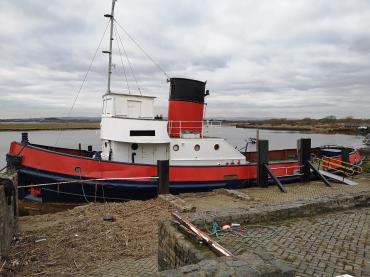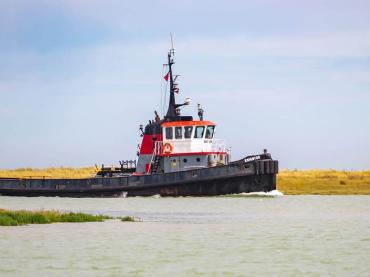Details
Construction
Dimensions
History
Built in 1954 by Cochrane & Sons of Selby for the Alexandra Towing Co. Ltd, CANNING is an oil burning steam tug with a triple expansion engine by C D Holmes & Co. Ltd., Hull. She was the first oil burning tug built for the company and, for the next 5 years, all other company tugs were of similar design and appearance. CANNING was based at Liverpool until being transferred to Swansea in 1966. Her main duties at both ports were towing and berthing large ships in the harbours and docks, but barge towage and coastal towage were also undertaken. She became the last steam tug to operate in the Bristol Channel, serving until 1974. In December 1974, she was acquired by Swansea City Council for preservation and has retained the fleet colours of the Alexandra Towing Co, Ltd; her original owners.
Source: Paul Brown, Historic Ships The Survivors (Amberley, 2010), updated Mar 2011.
Significance
What is the vessel’s ability to demonstrate history in her physical fabric?
Built in 1954 by Cochrane & Sons of Selby for the Alexandra Towing Co. Ltd, CANNING is an oil burning steam tug with a triple expansion engine by C D Holmes & Co. Ltd., Hull. She was the first oil burning tug built for the company and, for the next 5 years, all other company tugs were of similar design and appearance. Her level of originality is very high. Some areas of overplating on the hull and deck have been completed as part of her preservation, otherwise she remains as she was when taken out of service in 1974. Her triple expansion steam engine and oil-fired boilers are an original example of what was the final evolution of marine steam power plants.
What are the vessel’s associational links for which there is no physical evidence?
Alexandra Towing Co. Ltd formed in 1887 was so names because it was based in Liverpool's Alexandra Dock, and in deference to the, then, Princess of Wales. Having been awarded contracts by both the Cunard Steamship Company and the White Star Line to handle their liners, operations expanded beyond Liverpool. Operations in Swansea began in 1924. CANNING was based at Liverpool until being transferred to Swansea in 1966. Her main duties at both ports were towing and berthing large ships in the harbours and docks, but barge towage and coastal towage were also undertaken. She became the last steam tug to operate in the Bristol Channel, serving until 1974. She then passed to Swansea Council and has been a floating museum exhibit since.
Whilst in Liverpool, she had a crew member by the name of Ronald Wycherley (17 April 1940 – 28 January 1983), better known as Billy Fury. Billy was an English musician and actor. An early star of rock and roll, he equaled the Beatles' record of 24 hits in the 1960s and spent 332 weeks on the UK chart. CANNING provides us with an original example of an oil-fired steam tug, one of the many that during the days before containerization would have handled cargo and passenger vessel operations in the ports around our coast.
How does the vessel’s shape or form combine and contribute to her function?
Despite CANNING currently being in need of a repaint, she remains an aesthetically pleasing harbour tug in form and appearance. The tall smokestack and davit hung lifeboat give her the appearance of a proper little working ship. She retains the colour scheme of the Alexandra Towing Co which complements the hull and superstructure shape. She remains as a static afloat exhibit in Swansea marina, without public access but in an area of high footfall, providing a clear link to the ports past. She is not operation, but does retain all original machinery, fixtures and fittings.
Key dates
-
1954
Built by Cochrane of Selby
-
1974
Bought by Swansea City Council for preservation
Sources
P N Waine, British Steam Tugs (1983) pub: Waine Research
Steamboat Register: An illustrated Register of surviving steam vessels in the British Isles (May Edition 6, 1994) pub: Steam Boat Association of Great Britain
W B Hallam, Blow Five: A History of the Alexandra Towing Co Ltd (1976)
C R Kaye, Fact Sheet: The Alexandra Towing Company Ltd pub: Swansea Maritime and Industrial Museum
C R Kaye, Exhibit Sheet: Steam Tug Canning pub: Swansea Maritime and Indistrial Museum
Own this vessel?
If you are the owner of this vessel and would like to provide more details or updated information, please contact info@nationalhistoricships.org.uk









